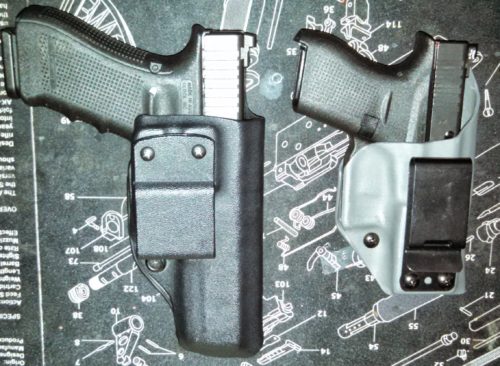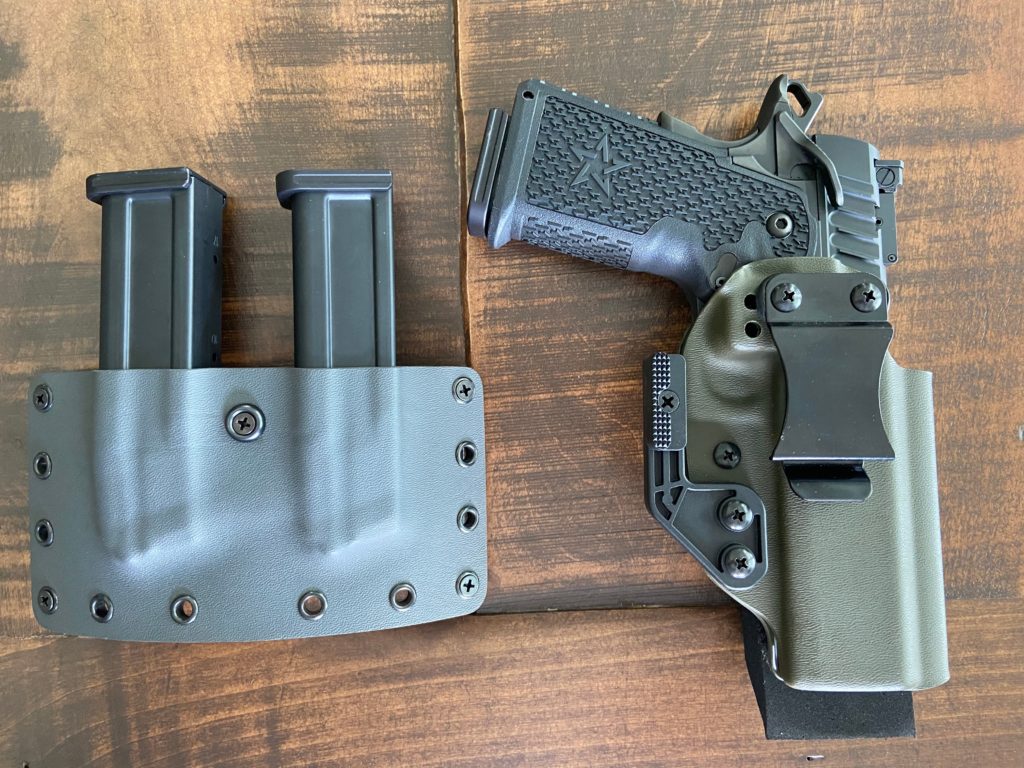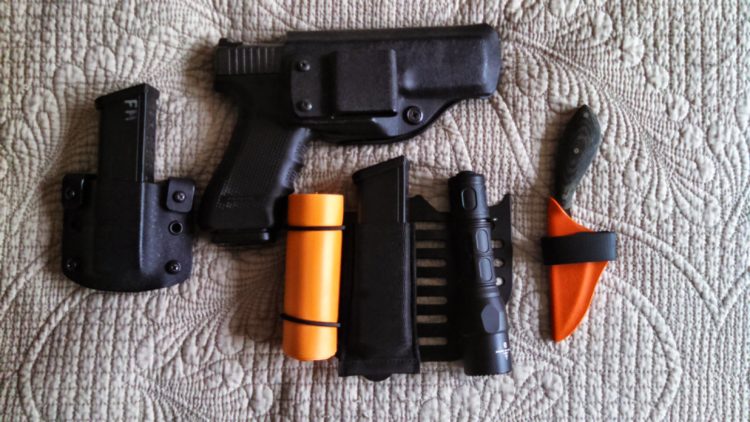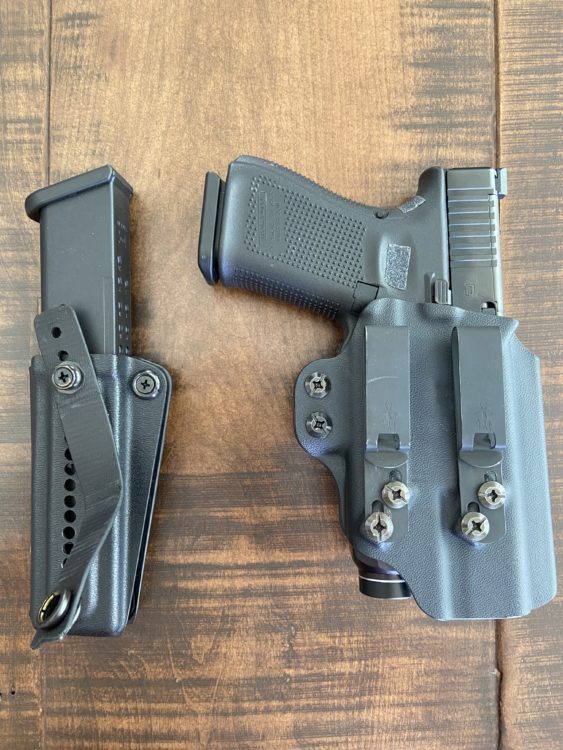There can be little doubt that appendix inside the waistband (AIWB) carry has seen a resurgence of popularity within the last decade or so, and for good reason. AIWB carry generally facilitates the ability to successfully carry a service-sized handgun concealed, provided you put in the work to dress around the gun (not wearing a spandex shmedium shirt while rocking your G19 Roland Special in the 1 o’clock). Generally speaking, AIWB carry means that you’re carrying a handgun in the 1 o’clock position as a right-handed shooter, and 11 o’clock as a southpaw. With that established, how did I make the journey from AIWB sceptic to a full-fledged believer? Read on…….
My Journey to AIWB-dom
It was January 2010. I’d been home from deployment a few weeks and decided that I wanted to give my pistol skills a tune-up. At the behest of a friend, I enrolled in a handgun class with late Todd Louis Green. Now, at this point in my shooting career, I thought that I was an accomplished pistolero, as I could easily outshoot my friends on a static range, and without any sort of metric for measuring performance (shot-timer). At the class, I was carrying my Gen 3 GLOCK 19 using outside the waistband (OWB), and I had really no concept of on-demand performance and speed. Sure, I’d passed military handgun quals with relative ease, so no big thing, right? Wrong. In the class, while on a timer, I was consistently getting my clock cleaned by shooters who were drawing their handguns from a position that I’d never seen before at that point- appendix inside the waistband carry. I took note on how quickly and efficiently they drew, presented to target, got their hits, and safely and deliberately reholstered. Watching Todd G demo on the range was a defining moment in my shooting career. He was funny, eloquent, stern when he needed to be, and was never afraid to tell you like it was. Above all, he was an instructor who was imminently knowledgeable about the material he was teaching and could explain the concepts and reasoning behind every draw stroke, press-out, sight picture, emergency reload and so much more. It was like drinking from the proverbial fire hose. After considerable research and deliberation, I decided to take the AIWB plunge later in 2010, first employing the Custom Carry Concepts Loop and Shaggy, rocking my pair of Smith & Wesson M&P 9’s in these holsters for the better part of 18 months. In the years that followed, I’ve carried a variety of handguns in the AIWB position, to include the following;
Beretta 92/PX4
CZ P09
GLOCK 17/19
HK P30 / VP9
STI Staccato P
S&W M&P 9/Shield 9
Walther PPQ/PPS
As a result, I’ve owned and worn a plethora of pistols in a variety of AIWB specific holsters. The vast majority of the holsters that I’ve used over the years have been excellent, and the ones that were either uncomfortable or lacked durability have been jettisoned. Currently, one has only to shop online for holsters to be inundated with an endless selection of leather and kydex offerings for AIWB- so where does one even begin to select a quality holster that’s right for them?
Think- Before we proceed any further, think if AIWB is the method of carry that you really want to pursue. Carrying a firearm for defensive purposes is an inherently dangerous activity, and the gun gods will not smile upon you if you are sloppy, careless or cavalier in your weapons handling. Given the orientation of the pistol and its very close proximity to your wedding tackle and femoral artery, if you choose a poor-quality holster, or you make a mistake while drawing or holstering, you could very well incur a life-threatening injury.
Quality- Given the positioning of the handgun in AIWB, a well-constructed holster, made specifically for AIWB, if a must. That means that it’s made from either kydex or a quality leather, and the holster covers the trigger in its entirety. Holsters that fail to cover the trigger completely permit things to migrate into the holster, such as drawstrings, which can, if the stars align, invite catastrophe. If your holster is made from some type of cheap nylon, and costs about the same as a latte at your local coffee shop, that’s generally a clue that it shouldn’t warrant consideration from you. On that note, be aware that many quality holsters are not exactly inexpensive. Typically, they can run from $70 to $150, but you are getting a product that has been vetted and tested by various industry professionals and SMEs, and these items will be durable and have a customer support network behind them. I’ll enclose link for my go-to holster folks below.
Comfort- If a holster isn’t comfortable, you’ll probably just leave your carry gun at home. AIWB is very body type-dependent, so you may have to experiment a bit with various holster/belt combinations. On that note, you do need a good quality belt which provides the necessary rigidity and support for carrying a service-sized handgun and spare magazine(s) on your beltline. Cheaping out and using a department store belt from 1986 will probably ensure that this method of carry is NOT comfortable and does not provide you with the requisite support. You’ll notice on many quality AIWB offerings that they offer either a removable foam wedge, affixed on the lower part of the holster near the muzzle (some makers have integrated this wedge into the holster via molding, or an integrated wing claw. Both of these features cam the muzzle of the handgun angled slightly outward, resulting in the grip being tucked in closer to your abdomen. On that note, let’s move on to concealability.
Concealability- I like to think of AIWB carry as a system- holster, pistol, spare ammo and cover garment. First, depending on your body type, you may wish to invest in pants which are sized one waist size larger than you normally wear. This makes the additional girth of a holster/handgun in your waistband a little bit more comfortable. Your cover garment can be a t-shirt, polo, sweatshirt or button up which has adequate length to cover your handgun in the event that you reach for something, and should be roomy enough to not reveal the outline of the grip should you be subjected to a gust of wind. An easy test is to put on your cover garment, look in the mirror, and raise both arms. If your cover garment rides up and reveals your pistol (or comes close) , it might be time to get something a little bit longer. Depending on your line of work or what your daily routine looks like, the penalties for being discovered with a concealed handgun can vary in severity, ranging from a comment from a fellow citizen to having law enforcement called. With the presumption that everyone reading this obeys all applicable laws pertaining to the lawful carry of a handgun, it’s never a good idea to blow your own cover. Put some time and thought into your clothing selection and save yourself a headache down the road.
Additional Gear- If you’re carrying a semi-automatic handgun for defensive purposes, it might be wise to consider carrying a spare magazine. For AIWB, I’ve carried spare mags at my 9 o’clock (support side hip) as well as in the 12 o’clock (AIWB), the latter requiring a well thought out magazine pouch. For the last year or so, I’ve been using the excellent Dark Star Gear Koala pouch. It’s a dedicated AIWB mag pouch that’s allows for adjusting the seating depth of your magazine. Rocking a 15 round G19 mag? No worries. A 24 round G17 mag? Gotcha covered.
Final Thoughts- AIWB carry is the method that I choose to carry a handgun when I am off-duty, due to the comfort, ease of concealability and peace of mind knowing that I have a duty-sized handgun on my person. If you think that this method of carry isn’t for you, that’s absolutely okay.




